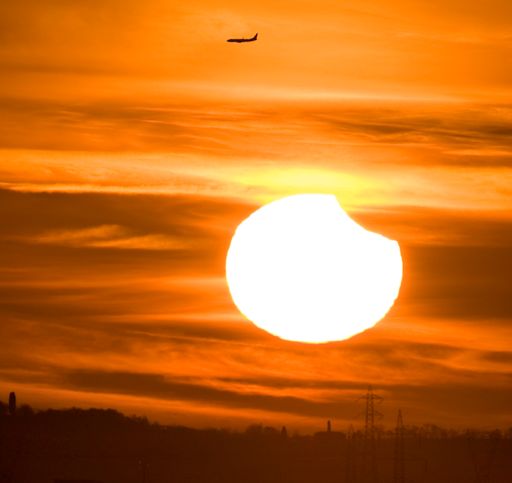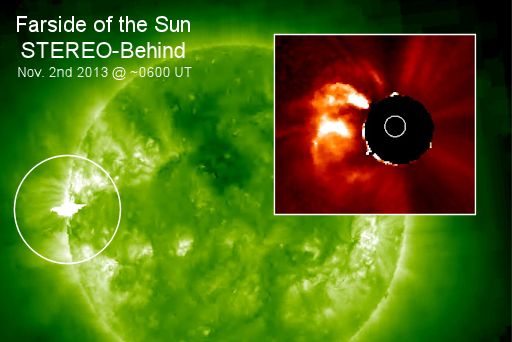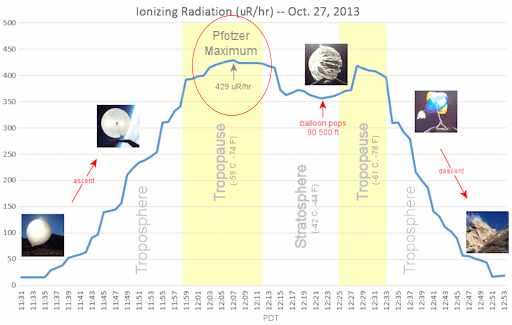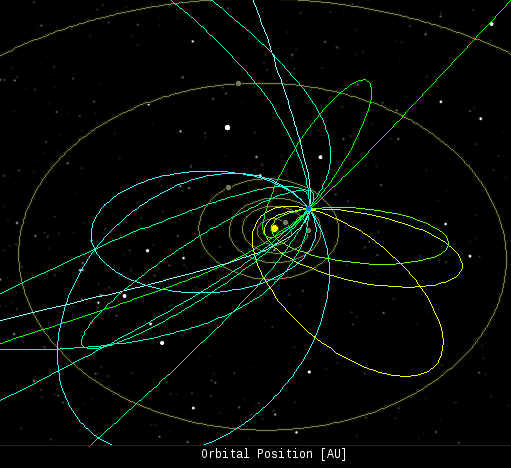When is the best time to see auroras? Where is the best place to go? And how do you photograph them? These questions and more are answered in a new book, Northern Lights - a Guide, by Pal Brekke & Fredrik Broms. | | |
WHAT DOES DEEP SPACE SOUND LIKE? As Voyager 1 recedes from the solar system, researchers are hoping the spacecraft will beam back tones from plasma waves, a form of "interstellar music" that reveals conditions in the realm of the stars. Find out what deep space sounds like in a new video from Science@NASA.
SUNRISE SOLAR ECLIPSE: Early Sunday morning, sky watchers along the east coast of North America might notice something missing--a piece of the sun. A partial eclipse will be underway at sunrise. Dawn will look something like this:

Above: A sunrise eclipse in Italy on Jan. 4, 2011. Credit: Antonio Finazzi [More]
As much as 54% of the sun will be covered by the New Moon; the size of the bite depends on location. To see it, look east between about 6:30 am and 7 am EST. Although low-hanging clouds might dim the sun to naked-eye visibility, safe solar filters are strongly recommended. Aluminized Mylar and #14 welder's glass are popular choices. Also, don't forget that Daylight Time changes to Standard Time at 2 am on Nov. 3rd. Set your clocks back one hour before the eclipse begins!
Sunrise is just the beginning. Next, the eclipse races across the Atlantic toward Africa where coverage reaches 100%. Inside a narrow path of totality, sky watchers can see the sun's ghostly corona spring out from behind the Moon. The dark core of the Moon's shadow will touch parts of several African nations including Gabon, the Congo, Uganda, Kenya, Ethiopia and Somalia. In those places, totality can be seen. Meanwhile, a partial eclipse will be visible across the entire continent: visibility map.
More information from NASA , Sky and Telescope, EarthSky and Shadow & Substance.
Realtime Space Weather Photo Gallery
FARSIDE SOLAR ACTIVITY: This weekend, solar activity has quieted on the Earthside of the sun, but the farside is still lively. NASA's twin STEREO probes have recorded solar flares and coronal mass ejections from multiple farside blast sites on Nov. 2th. STEREO-Behind photographed this powerful eruption around 0600 UT:

The farside active regions STEREO is observing now pose no threat to Earth, but they could become geoeffective in ~10 days when the sun turns them toward our planet.
Until then, the sunspot of greatest interest to Earth is AR1884. Directly-facing Earth, it has a mixed-polarity magnetic field that harbors energy for strong eruptions. NOAA forecasters estimate a 30% chance of M-class flares and a 5% chance of X-flares on Nov. 2nd and 3rd. Solar flare alerts: text, voice.
Realtime Aurora Photo Gallery
RE-DISCOVERING THE PFOTZER MAXIMUM: On Oct. 27th, when the students of Earth to Sky Calculus launched a pair of radiation sensors to the stratosphere onboard a helium balloon, they didn't know what to expect. This just in: They have re-discovered the Pfotzer Maximum. Most people have never heard of it. The Pfotzer Maximum is a layer of peak radiation about 20 km above Earth's surface. Take a look at this data plot from the team's space weather balloon and keep reading below for more information:

The plot shows a complete profile of ionizing radiation between 2.7 km and 27 km above Earth's surface. Data from their sensor counted X-rays and gamma-rays in the energy range 10.0 KeV to 20.0 MeV. A peak in radiation levels occured in the tropopause--that's the Pfotzer Maximum.
When cosmic rays crash into Earth's atmosphere, they produce a spray of secondary particles. With increasing depth in the atmosphere, the primary cosmic radiation component decreases, whereas the secondary radiation component increases. This complex situation results in a maximum of the dose rate at an altitude of ~20 km, the so-called "Pfotzer maximum," named after physicist George Pfotzer who discovered the peak using balloons and Geiger tubes in the 1930s.
The Earth to Sky experiment was prompted by a recent NASA report concerning the effects of space weather on aviation. Like astronauts, ordinary air travelers can be exposed to significant doses of radiation when the sun is active. Data collected by balloon-borne sensors can be used to check and improve research models of radiation percolating through Earth's atmosphere.
The students are ready to fly their sensors again. A radiation storm in the week ahead is a possibility as solar activity remains high. If one erupts, they plan to revisit the Pfotzer Maximum to find out how it reacts. Stay tuned. Solar flare alerts: text, voice.
Realtime Space Weather Photo Gallery
Realtime Comet ISON Photo Gallery
Realtime Aurora Photo Gallery
NEW: Every night, a network of
NASA all-sky cameras scans the skies above the United States for meteoritic fireballs. Automated software maintained by NASA's Meteoroid Environment Office calculates their orbits, velocity, penetration depth in Earth's atmosphere and many other characteristics. Daily results are presented here on Spaceweather.com.
On Nov. 2, 2013, the network reported 12 fireballs.
(9 sporadics, 1 Orionid, 1 Northern Taurid, 1 omicron Eridanid)

In this diagram of the inner solar system, all of the fireball orbits intersect at a single point--Earth. The orbits are color-coded by velocity, from slow (red) to fast (blue). [Larger image] [movies]
Potentially Hazardous Asteroids (
PHAs) are space rocks larger than approximately 100m that can come closer to Earth than 0.05 AU. None of the known PHAs is on a collision course with our planet, although astronomers are finding
new ones all the time.
On November 2, 2013 there were 1437 potentially hazardous asteroids.
Notes: LD means "Lunar Distance." 1 LD = 384,401 km, the distance between Earth and the Moon. 1 LD also equals 0.00256 AU. MAG is the visual magnitude of the asteroid on the date of closest approach. | | The official U.S. government space weather bureau |
| | The first place to look for information about sundogs, pillars, rainbows and related phenomena. |
| | Researchers call it a "Hubble for the sun." SDO is the most advanced solar observatory ever. |
| | 3D views of the sun from NASA's Solar and Terrestrial Relations Observatory |
| | Realtime and archival images of the Sun from SOHO. |
| | from the NOAA Space Environment Center |
| | the underlying science of space weather |

